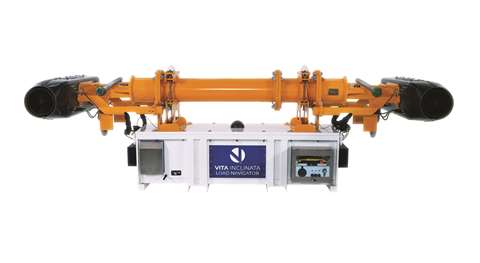Vita Inclinata CEO develops lifesaving stabilization technology
30 November 2022
It was during his time volunteering for an Oregon search and rescue team in 2009 when teenage Caleb Carr witnessed the unspeakable as a friend and mentor suffered from cardiac arrest during a routine training exercise. Due to a variety of factors, including wind and terrain, the Black Hawk helicopter basket was unable to reach Carr’s fellow volunteer, and the rescue was ultimately called off.
After the harrowing event, Carr later found himself on the path to medical school at the University of Colorado, having discovered he had a passion for saving lives. But as the issue tagline hazards continued to plague him, Carr was challenged by a professor who infamously said, “Why the hell don’t you fix the problem?” Vita Inclinata Technologies, originating from a story of immense loss, has since evolved into a global presence with goals set on enhancing jobsite safety and eliminating the threat of spinning loads. And as of late, a training program for operators has also been added to the Vita ecosystem.
 Creative Lifting Services utilized Vita Load Navigator technology on a crowded tower crane erection.
Creative Lifting Services utilized Vita Load Navigator technology on a crowded tower crane erection.
“If we can train the operators of the future, you can empower technology to be infused with the current workers of today to enable them to feel confident, but also to be able to utilize technology,” said Carr, who serves as chairman and CEO. “Not to eliminate jobs, but rather to empower them to be able to leverage it to do their jobs better, more efficiently and ultimately safer.”
Carr created the company initially to solve load stabilization issues underneath helicopters, which then evolved into loads on cranes that start spinning out of control. “It’s been a unique journey learning the industrial ecosystem versus aerospace and helicopter,” he said.
Through Vita, he has set out to eliminate injury and death in hoist and load operations. And in doing so, he also hopes to change the face of a technology company to that of a collaborator, a connector and a facilitator. And in what originated as a startup, the Broomfield, CO-based company now has offices all over the globe and nearly 90 employees.
Leveraging technology for crane and rigging safety
But with a chuckle, Carr said that he will never start another company after Vita. The Colorado native is “executing his mission and then going back to being a firefighter.”
I caught up with him via Microsoft Teams during a rare evening of downtime in Dubai, right before catching a flight to Munich for Bauma. I think you’ll find his perspective on the crane and rigging industry refreshing, and his outlook on safety practices and labor shortage peppered with a contagious optimism.
 Caleb Carr, Chairman and CEO, Vita Inclinata Technologies
Caleb Carr, Chairman and CEO, Vita Inclinata Technologies
How does Vita Technology make a job safer?
We eliminate the need for the use of any taglines. But more specifically, we eliminate the threat of spinning loads from impacting either property or people. I can provide an assurance to a crane operator, rigger or even a GC and say, look, if you are operating within the parameters that we’ve set for the technology, I can assure you that in no situation will you have an event that someone’s going to be injured or a piece of property is going to be impacted. And in today’s world, when that’s happening every single day at some point in the United States, that’s a pretty significant impact. And that’s ultimately what we’re trying to do.
Could you describe what the reception has been to your products?
Curiosity. In the construction space, it’s a very historical industry where those who are a part of it understand what they do, and do it well. But when you start introducing new tools, it’s a question of, okay, what is that tool? How do I leverage it? And that’s again why training has become so important. We get a lot of curiosity, but then the next question is, how do I introduce this tool? I have a new piece of technology that I can leverage. But the user also has a new piece of technology that’s going to slow them down for a couple weeks until they get used to it. So that’s been the process that Vita spends a lot of time on. Educating through curiosity, and being able to execute the value add that the technology brings.
Can you tell me about the Vita Industrial Training Academy and what programs are offered?
We are offering everything from rigger training to crane operator training. We will do qualifications for crane riggers, crane operators, OSHA 10 and OSHA 30. We also offer both online and in person team development, data management and a number of other courses that you can go check out online. The goal is to be able to provide operators around the world, whether it’s because they’re coming off Covid or they’re looking for a new kind of gig, to be able to get into. We are finding those workers, we’re empowering them to take our courses, and then we are working with the larger operators to be able to say, hey, we have a community of operators that you can leverage.
 The Vita Load Navigator provides continuous stabilization that stops spinning loads.
The Vita Load Navigator provides continuous stabilization that stops spinning loads.
What would you like to see 10 or 15 years down the line? What do you envision for the company?
So, our mission is that we build technology that brings people home every time. My goal is not to get technology necessarily on every crane. My goal is to eliminate all the injuries and risks that are caused by uncontrolled suspended loads on the crane. If we have fulfilled that, that’s mission accomplished in 10 years. That’s where we put a lot of our focus and a lot of our efforts. And that’s why you will see us invest and continue to invest in consolidating and enhancing the learning community around safe rigging practices and safe crane practices, but also leveraging technology to be able to do both of those safer and more efficient. Efficiency is going to continue to drive and be more of a narrative in the years to come. It’s going to be absolutely imperative that the fusion of technology with history and legacy is fused in the right way where it’s not prohibitive but empowered.
What’s your favorite part of the crane and rigging industry that maybe you weren’t expecting?
The biggest thing is the people. Naturally in the aviation space, and even being a firefighter, you have a community of people that are very tight knit, very collaborative and a lot of camaraderie. The construction industry’s the exact same thing. I’ve gone to sites before and quite literally the dynamic of a construction site is no different than my firehouse. And that’s absolutely amazing.




